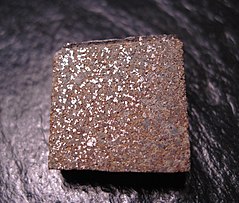Wuan (meteoryt)
| ||
 Meteoryt Wuan | ||
| Sposób odkrycia | spadły | |
|---|---|---|
| Państwo | ||
| Miejsce znalezienia | Hebei | |
| Data znalezienia | 31 lipca 1986 | |
| Masa | 50 kg | |
| Typ | meteoryt kamienny, chondryt | |
| Klasa | oliwinowo-hiperstenowy | |
| Grupa | H6 | |
Wuan – meteoryt kamienny należący do chondrytów oliwinowo-bronzytowych H 6, spadły o godzinie 11:00 31 lipca 1986 roku w chińskiej prowincji Hebei, w pobliżu wioski Wu’an. Z miejsca upadku meteorytu pozyskano 50 kg materii meteorytowej. Meteoryt Wuan jest trzecim i największym, jak dotąd, meteorytem znalezionym w prowincji Hebei.
Bibliografia
- Meteoritical Bulletin Entry for Wuan (ang.). The Meteoritical Society, International Society for Meteoritics and Planetary Science. [dostęp 2011-08-13].
Media użyte na tej stronie
Autor: Uwe Dedering, Licencja: CC BY-SA 3.0
Location map of China.
EquiDistantConicProjection : Central parallel :
- N: 36.0° N
Central meridian :
- E: 104.0° E
Standard parallels:
- 1: 30.0° N
- 2: 42.0° N
Latitudes on the central meridian :
- top: 57.0° E
- center: 37° 29′ N
- bottom: 17.96° N
Shiny orange button/marker widget.
(c) Rob Lavinsky, iRocks.com – CC-BY-SA-3.0
Iron (Var.: Kamacite)
- Locality: Nantan meteorites (Nandan meteorites), Lihu - Yaochai area, Nandan County, Hechi Prefecture, Guangxi Zhuang Autonomous Region, China (Locality at mindat.org)
- Size: 7.9 x 4.2 x 3.9 cm.
- A LARGE meteorite from a witnessed fall! From the accompanying literature: "Nantan iron meteorites represent one of the rare witnessed iron meteorite falls in the world. The fall was vividly recorded (in Chinese records): “During summertime in May of Jiajing 11th year, stars fell from the northwest direction, five to six fold long, waving like snakes and dragons. They were bright as lightning and disappeared in seconds. These records show the meteorite to have fallen in the year 1516 AD. The fall site was not discovered until much later, in 1958. The specimens have a coarse octahedral structure, and contain 92.35% iron and 6.96% nickel, belonging to IIICD classification of Wasson et al (1980’s).” This is a VERY LARGE one, weighing 223 grams!
Autor: Jon Taylor, Licencja: CC BY-SA 2.0
After detonations, this H6 chondrite was witnessed to fall on July 31, 1986, in Hebei Province, China. The main mass is held by the Bejing planetarium. This is a nice 7.6 gram partial slice with fusion crust along the top edge. Obtained from the M. Bandli collection.






